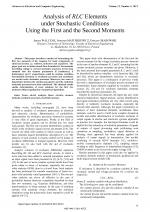| 4/2015 - 10 |
Analysis of RLC Elements under Stochastic Conditions Using the First and the Second MomentsWALCZAK, J. |
| View the paper record and citations in |
| Click to see author's profile in |
| Download PDF |
Author keywords
circuit analysis, linear circuits, moment methods, stochastic processes, stochastic systems
References keywords
stochastic(18), circuits(9), equations(6), kolarova(5), modeling(4), circuit(4), applications(4)
Blue keywords are present in both the references section and the paper title.
About this article
Date of Publication: 2015-11-30
Volume 15, Issue 4, Year 2015, On page(s): 75 - 80
ISSN: 1582-7445, e-ISSN: 1844-7600
Digital Object Identifier: 10.4316/AECE.2015.04010
Web of Science Accession Number: 000368499800010
SCOPUS ID: 84949967914
Abstract
This paper describes a method of determining the first two moments of the response for basic components of electrical circuits, i.e. resistors, inductors and capacitors. The paper goal was to obtain closed form formulae for the moments describing voltage or current stochastic processes. It has been assumed that the element parameters R (resistance), L (inductance) and C (capacitance) could be random variables, deterministic functions or stochastic processes and excitations are second order stochastic processes. Moreover, two cases of dependence between the random parameters and the excitation stochastic processes have been considered. The obtained results enable determination of exact solutions for the first two moments without application of numerical algorithms. |
| References | | | Cited By |
Web of Science® Times Cited: 2 [View]
View record in Web of Science® [View]
View Related Records® [View]
Updated today
SCOPUS® Times Cited: 2
View record in SCOPUS® [Free preview]
View citations in SCOPUS® [Free preview]
[1] Numerical simulation of fractional-order dynamical systems in noisy environments, Mostaghim, Zeinab Salamat, Moghaddam, Behrouz Parsa, Haghgozar, Hossein Samimi, Computational and Applied Mathematics, ISSN 0101-8205, Issue 5, Volume 37, 2018.
Digital Object Identifier: 10.1007/s40314-018-0698-z [CrossRef]
[2] Confidence intervals for RLCG cell influenced by coloured noise, Kolarova, Edita, Brancik, Lubomir, COMPEL - The international journal for computation and mathematics in electrical and electronic engineering, ISSN 0332-1649, Issue 4, Volume 36, 2017.
Digital Object Identifier: 10.1108/COMPEL-07-2016-0321 [CrossRef]
Disclaimer: All information displayed above was retrieved by using remote connections to respective databases. For the best user experience, we update all data by using background processes, and use caches in order to reduce the load on the servers we retrieve the information from. As we have no control on the availability of the database servers and sometimes the Internet connectivity may be affected, we do not guarantee the information is correct or complete. For the most accurate data, please always consult the database sites directly. Some external links require authentication or an institutional subscription.
Web of Science® is a registered trademark of Clarivate Analytics, Scopus® is a registered trademark of Elsevier B.V., other product names, company names, brand names, trademarks and logos are the property of their respective owners.
Faculty of Electrical Engineering and Computer Science
Stefan cel Mare University of Suceava, Romania
All rights reserved: Advances in Electrical and Computer Engineering is a registered trademark of the Stefan cel Mare University of Suceava. No part of this publication may be reproduced, stored in a retrieval system, photocopied, recorded or archived, without the written permission from the Editor. When authors submit their papers for publication, they agree that the copyright for their article be transferred to the Faculty of Electrical Engineering and Computer Science, Stefan cel Mare University of Suceava, Romania, if and only if the articles are accepted for publication. The copyright covers the exclusive rights to reproduce and distribute the article, including reprints and translations.
Permission for other use: The copyright owner's consent does not extend to copying for general distribution, for promotion, for creating new works, or for resale. Specific written permission must be obtained from the Editor for such copying. Direct linking to files hosted on this website is strictly prohibited.
Disclaimer: Whilst every effort is made by the publishers and editorial board to see that no inaccurate or misleading data, opinions or statements appear in this journal, they wish to make it clear that all information and opinions formulated in the articles, as well as linguistic accuracy, are the sole responsibility of the author.





